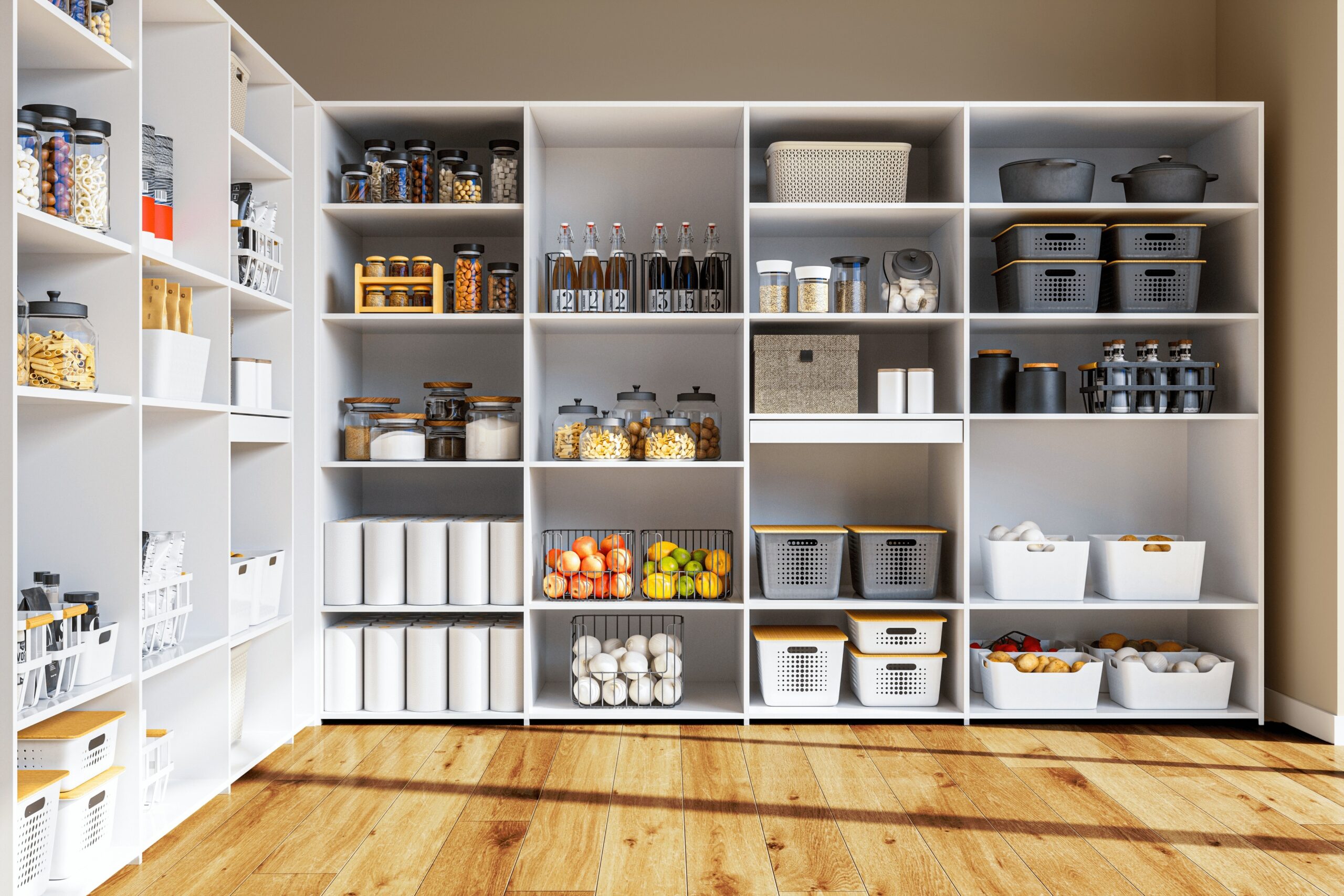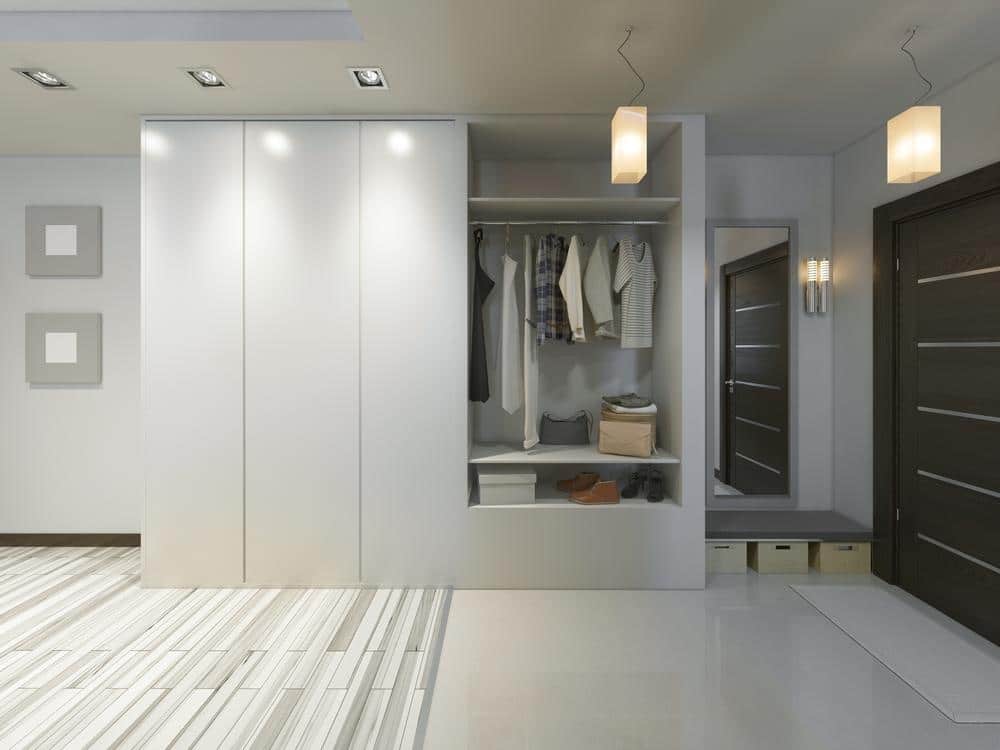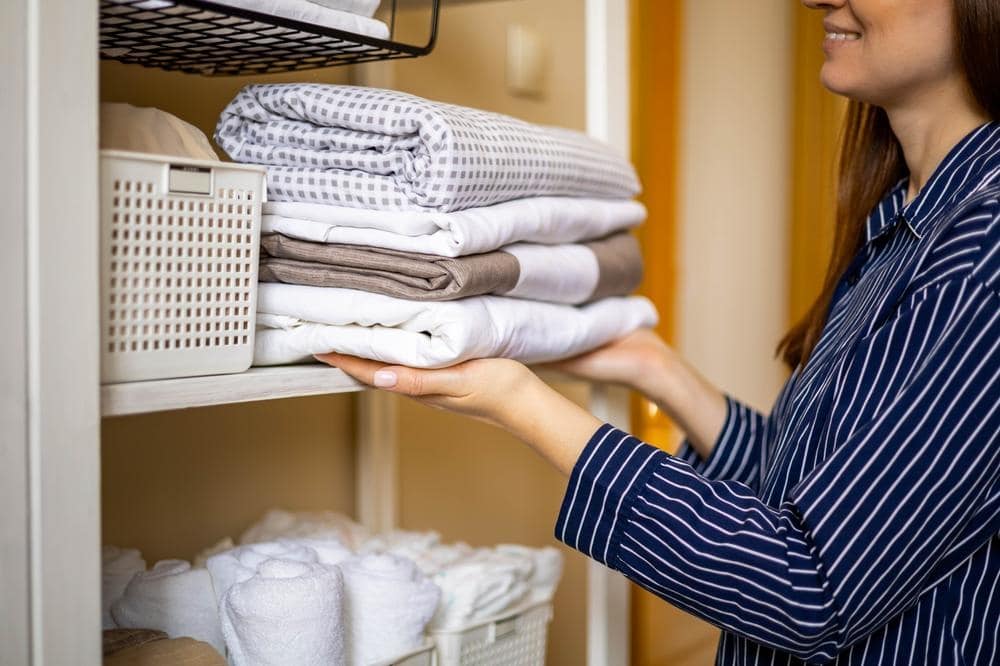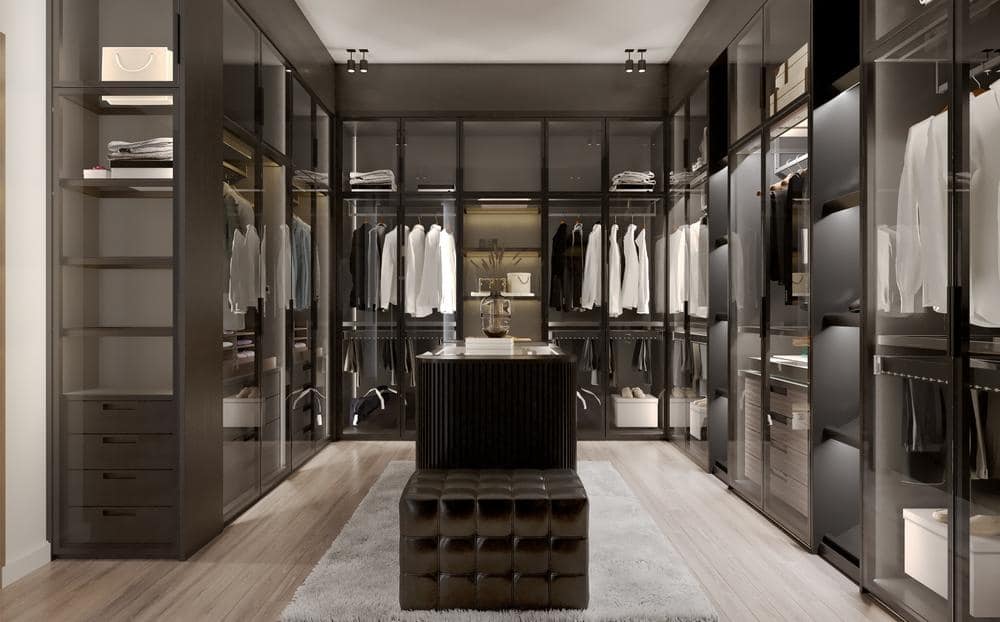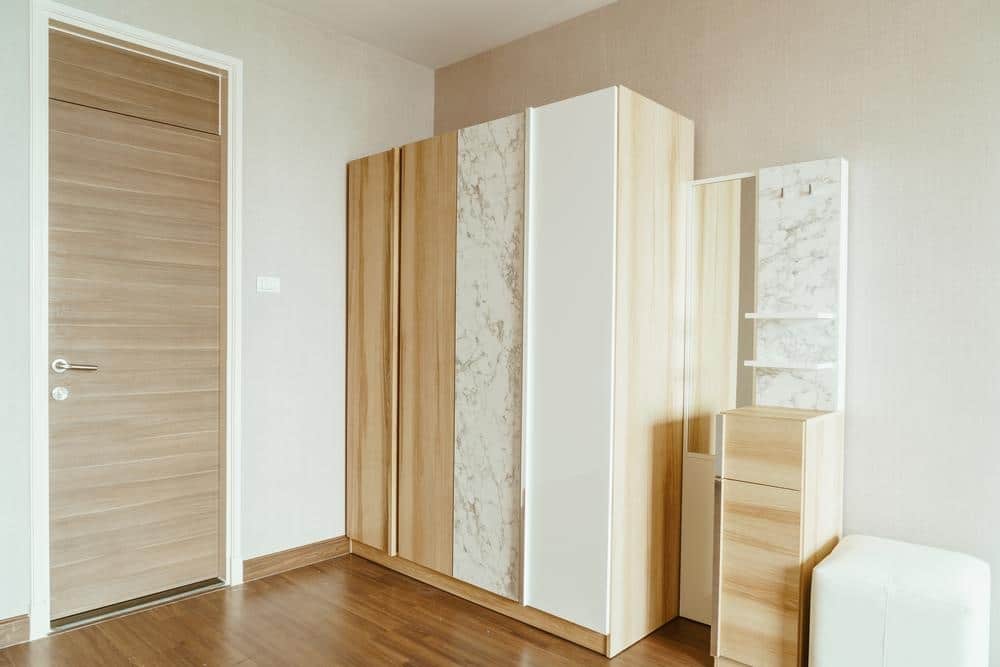What is the key to having a spotless kitchen? The answer can be found with a little help from behind the scenes. As our homes have become more open-plan, our kitchens have become more integrated with our living and dining areas, exposing and displaying our kitchens.
While this is great for creating a sense of connection, it isn’t so great if you’re a messy cook or don’t get to clean up immediately after each meal or prep time.
A walk-in pantry is an excellent solution if you don’t want to spend time cleaning your kitchen.
This tiny cluster buster is a chef’s best friend and an entertainer’s dream. They can be used to prepare food, store appliances, and, most importantly, hide mess — especially during a dinner party!

Space Allocation in The Walk-in Pantry Design
Table of Contents
- Space Allocation in The Walk-in Pantry Design
- Steps For Planning The Perfect Walk-in Pantry
- Personalize The Space To Your Needs
- Make Even The Small Space Feel Like a Walk-in Pantry
- Carefully Consider How You Will Use The Space
- Get Your Walk-In Pantry Storage Spot On
- Divide A Walk-In Pantry With A Crittal Partition
- Show Off Your Pantry With Glass Doors
- Hang Open Shelving for Style And Practicality
- Functional Materials in The Walk-in Pantry Design
- Add Storage To The Inside Of Your Doors
- Make A Walk-In Pantry A Luxurious Feature
- Open Shelves and Plenty of Drawers in the Walk-in Pantry Design
- Maximize Bench Space in The Walk-in Pantry Design
- Hide it Away in The Walk-in Pantry Design
- Ditch The Doors So Everything Is Accessible
- Bright Task Lighting in The Walk-in Pantry Design
- Go Bold With Your Color Schemes
- Design a Space for Everything in The Walk-in Pantry
- How Deep Should Walk-In Pantry Shelves Be?
- How do you plan a walk-in pantry?
- What is a good size for a walk-in pantry?
- Are walk-in pantries a waste of space?
- How do you layout a walk-in pantry?
- What is a good size walk-in pantry?
- What is the average size of a walk-in kitchen pantry?
- Should a walk-in pantry have a window?
- Should you have a door on a walk-in pantry?
- Can you put a fridge in a walk-in pantry?
- How do you ventilate a walk-in pantry?
- How much does it cost to build a walk-in pantry?
- What is a walk-in pantry?
- What should be included in a walk-in pantry?
- What is the benefit of a walk-in pantry?
- What is the typical walk-in pantry size?
- What is the difference between a walk-in pantry and a pantry?
- What is the difference between a pantry and a cupboard?
- What is the difference between a walk-in pantry and a scullery?
- How do you organize a walk-in pantry?
- Does a walk-in pantry need a sink?
- What is a large walk-in pantry called?
- What are the specs for a walk-in pantry?
- How do you organize food in a walk-in pantry?
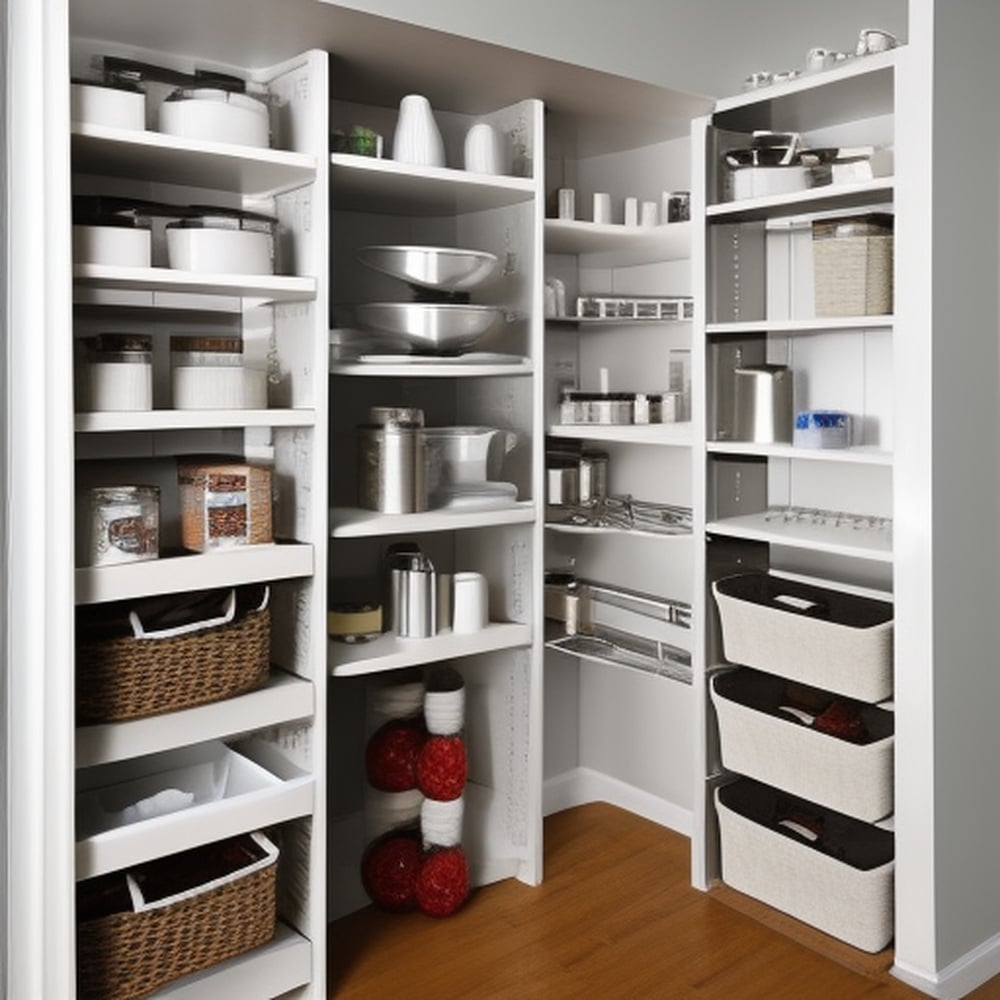
Consider how much space you have for a walk-in pantry, as this will influence the overall design — straight line, L-shape, or U-shape. The pantry should ideally be a natural extension of the kitchen.
As a general rule, allow at least 600mm for benchtops and 300mm for pantry shelving. The walkway’s width should be at least 1000mm (ideally 1100-1200mm if the space allows). Allow for a 2.4m x 3m space if you want to include a fridge, sink, or microwave.
Steps For Planning The Perfect Walk-in Pantry

Measure and Design
Start by measuring the existing space and visualize the best way to design it. If you are constructing a new pantry, figure out what size to make it and which wall would be best. Decide if there can be two levels or if it will all be in one. Will you want a space for an appliance like a freezer or refrigerator? Sketch the layout of the pantry and decide which items you want to store in it. Establish a plan prior to purchasing and building the pantry to make the most of the space.
Decide on Storage Tools
Once you have your measurements and layout down, consider the types of shelving and storage you would like to use. Evaluate what items to store in the pantry and think about what kind of shelves, baskets, and bins will best organize them. Walker-in pantries are known for having deep shelves, sliding drawers, or built-in drawers to maximize storage space. Drawers can be used for heavy items and help you keep a neat, minimalist look.
Utilize Vertical Space
Whether your pantry is square or round, there is the opportunity to use vertical space and save you a lot of room. Consider putting items like canned goods in vertical storage so that items can be easily lifted from four-palm drawers. Hanging baskets and other adjustable shelving can free up valuable space. Make sure to pay attention to the depth and height of the shelves for a more functional pantry.
Maximize Openness
When designing a walk-in pantry, one of the main elements often overlooked is maximizing openness. Open shelving allows for easier reconfiguration and optimizes the space you have to work with. Go ahead and float shelves or use clear containers so the pantry can have a cohesive, open look. This allows you to easily reach all items and make the pantry more accessible and efficient.
Personalize The Space To Your Needs
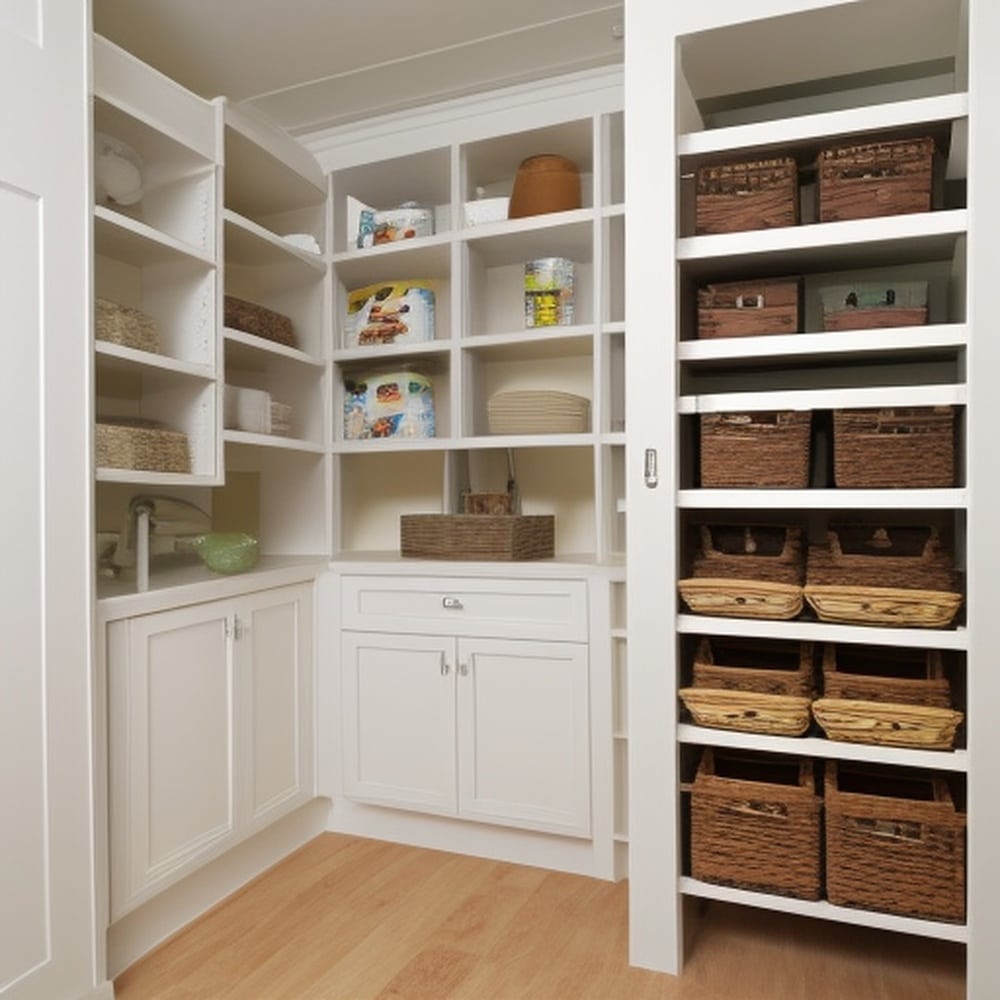
Personalizing your pantry space is a great way to make it more functional and organized. There are a few things you can do to make it your own. First, think about how you use your pantry. Do you need room for baking ingredients? Do you need space for canned goods or cereals? Once you know how you will use the space, you can start to get creative with how you organize your pantry. Shelves are a great way to store food and ingredients, as you can easily see what you have.
You can also use baskets to store snacks and items that don’t need to be kept in their original packaging. Bins also store bulk items like flour, sugar, and rice. If you have room, add a spice rack or a lazy Susan to make the most of your pantry space. Finally, labeling your items is a great way to keep track of everything. Simply use adhesive labels or use chalkboard labels to keep everything organized. You can personalize your pantry space with just a few simple steps to meet your individual needs.
Make Even The Small Space Feel Like a Walk-in Pantry

Even if you don’t need the biggest kitchens to add a walk-in pantry, you still need a little spare room. But you don’t need to dedicate much of your kitchen to it. It might be possible to create the impression of a walk-in pantry without sacrificing a lot of your kitchen by using glazing. This little pantry has been confined to a tiny section of the kitchen, but the doors create the impression of a walk-in pantry without the necessity for a lot of space. It’s ideal for storing glass jars.
Carefully Consider How You Will Use The Space
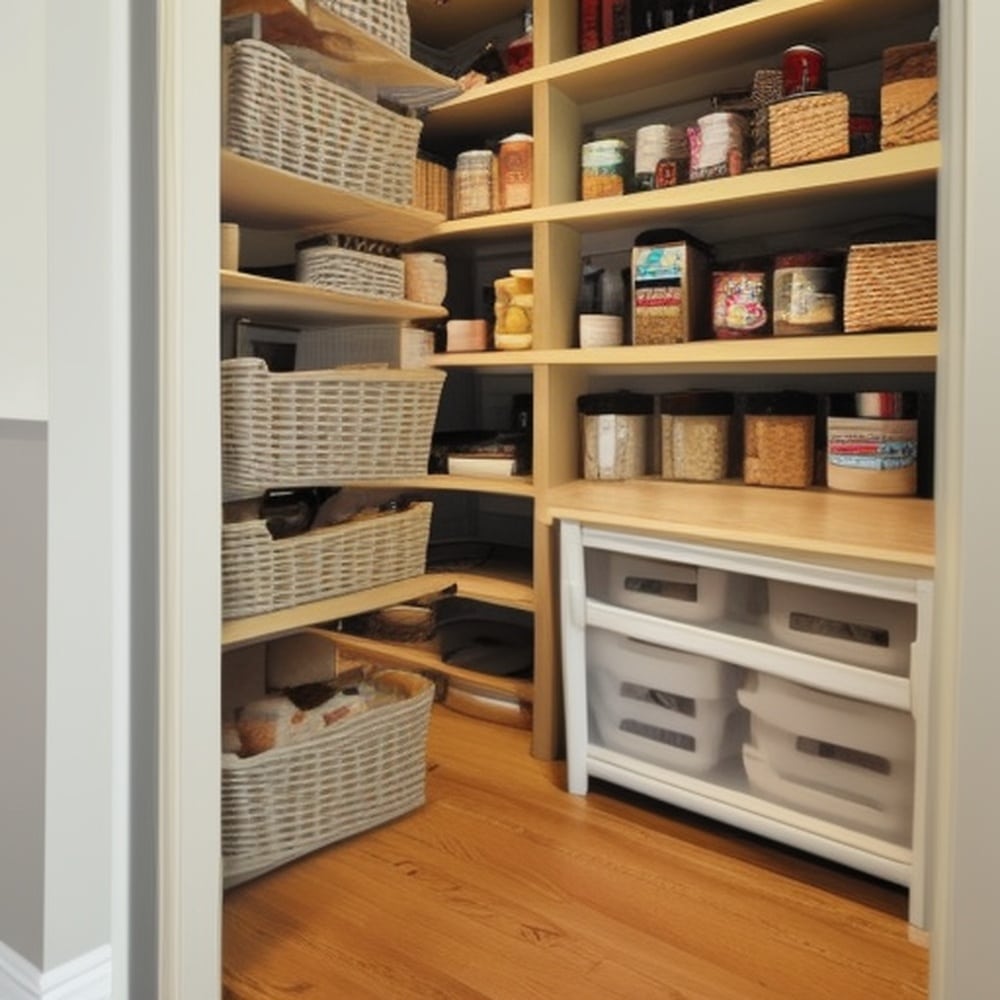
When setting up a walk-in pantry, it’s vital to align your pantry with how you cook and live. A pantry should reflect your lifestyle and the way you use your kitchen. To make a pantry work for you, you must first determine how much food you want to store and whether it should be seasonal or long-term. Will it be used every day or just occasionally? Will it contain ingredients and dried goods or less-used appliances?
Get Your Walk-In Pantry Storage Spot On
Of course, pantry organization is critical. Walk-in pantries are ideal for storing non-perishable goods. From cereals and spices to biscuits and dried pasta, a larder may hold various items and leave your countertops clear of mess. A personal approach to organizing may determine where you store your groceries.
Divide A Walk-In Pantry With A Crittal Partition
When designing a walk-in pantry, make sure you have a large kitchen with ample space to play around, as a solid wall between the two will only make the kitchen feel smaller, so opt for a glazed partition instead. Crittal doors are always in fashion and blend with any style, from contemporary to traditional. For example, this mismatch and blending of styles often contribute to the character and personality of a kitchen.
Show Off Your Pantry With Glass Doors
Some people may be hesitant to use open pantries to store their items because they think it will make the kitchen look untidy. However, it can actually open up the area and provide a sense of more space. Additionally, glass is an excellent material for kitchen cabinets as it can help bring in more light to darker areas and add variation to the look of solid front doors.
Hang Open Shelving for Style And Practicality
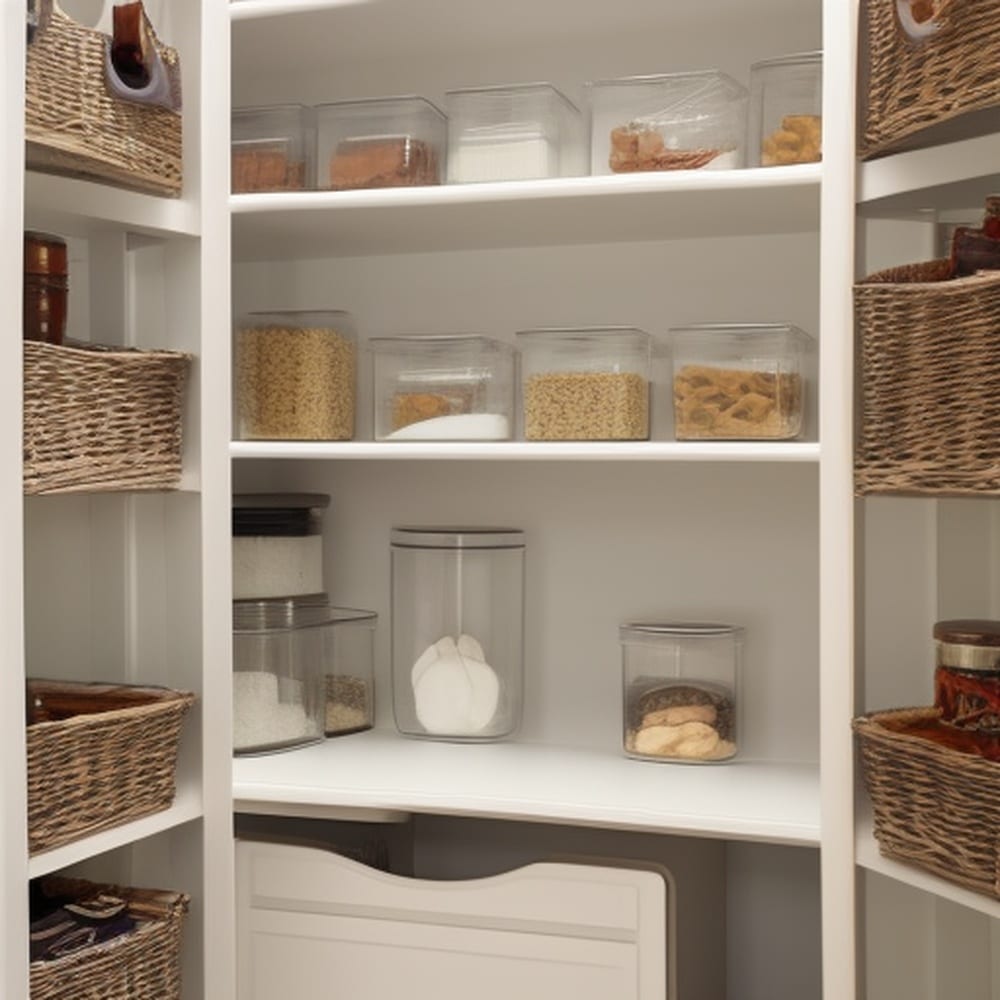
Using savvy storage ideas is critical to track what goes into your pantry. Open shelving is preferred right now, as it makes everything as accessible as possible and makes it easier to track what goes into the pantry. ‘A curated collection can be displayed with the nitty gritty working items cleverly tucked away on divided shelving walls or mixed in with concealed storage.’
Functional Materials in The Walk-in Pantry Design
If your walk-in pantry is quite open, it is critical to keep the finishes consistent with the rest of the kitchen. However, if your walk-in pantry is not fully open and on display, consider using less expensive materials to save money.
Instead of using the same materials as your main kitchen (which could be stone or marble), consider a more affordable option, such as a laminated benchtop, for a fraction of the price. Laminates can be closely matched to your primary bench color to ensure a seamless look.
Open shelving above cupboards will also help you stretch your budget even further. If you want cabinets, melamine doors are less expensive than laminate, polyurethane, or wood veneer.
Add Storage To The Inside Of Your Doors
Even when your pantry is big, you have to make the most of every inch of space when choosing kitchen cupboard storage – including the open space behind your doors. A pull-out rack and shelving on the inside of the cupboard doors are also handy space-saving techniques to keep in mind when designing a pantry. This party of your pantry is excellent for storing smaller items.
Make A Walk-In Pantry A Luxurious Feature

Although a pantry ought to be all-function, it can be just as beautiful as your kitchen and should be, particularly if it is on display. Your pantry should have character and be distinct from the others. Coffee and breakfast foods can also be prepared here, as well as smaller appliances. This striking marble kitchen has the pantry as the centerpiece and is one of the most prominent features of the room. Because a larger range of appliances can be stored here, other kitchen areas can be freed up.
Open Shelves and Plenty of Drawers in the Walk-in Pantry Design
The ability to walk in, take a look, and quickly grab what you need is essential for a successful pantry. For more storage, consider running your shelves to the ceiling.
You can keep items that you only use occasionally on the top shelves (which are more challenging to reach). Keep a small fold-up stool on hand to access the higher shelves safely.
Having a lot of drawers under your benchtop is a good idea. Drawers are easier to access and can be used to store items such as pantry essentials.
Maximize Bench Space in The Walk-in Pantry Design
Make use of as much bench space as possible in your walk-in pantry. Your walk-in pantry is ideal if you don’t want small appliances taking up valuable space in your main kitchen. This area can store small appliances such as toasters, kettles, blenders, mix masters, or a coffee machine.
Include as many power points as possible (at least four doubles — you can never have too many! ), allowing you to plug in and use the appliances on the benchtop so they are always ready to use.
Hide it Away in The Walk-in Pantry Design
Consider a cavity sliding door or a sleek bifold door for your pantry if space is limited. This is a great way to keep this area off-limits while hiding your mess behind closed doors! A tucked-away pantry completes the look of a modern kitchen while keeping it out of sight of the living and dining areas.
Ditch The Doors So Everything Is Accessible
Shelving and cabinets are great for storing a lot of stuff. Keeping your cabinets open ensures that nothing gets lost or forgotten, just like with shelves. The items you use on a regular basis should be placed front and center, while the items you don’t use as frequently should be kept further back.
Bright Task Lighting in The Walk-in Pantry Design
A walk-in pantry should have task lighting. Consider a motion sensor LED light that activates when you open the door. This is a great feature when you have an arm full of groceries. If you have overhead shelving, consider installing LED strip lighting beneath it to illuminate the benchtops. If you spend more time in there than in a standard walk-in pantry, consider adding natural light and ventilation, such as a window or skylight, to make it a more comfortable place to be.
Go Bold With Your Color Schemes
When it comes to kitchen colors, we all tend to be conservative – creams, whites, grays, and muted colors are always popular. However, behind closed doors, you can experiment with bold colors and use a walk-in pantry to add a splash of something colorful – as seen in this cheerful pink pantry. You may also utilize the color throughout the space, including the shelves, to make it a more prominent focal point.
Design a Space for Everything in The Walk-in Pantry
Plan out what you want in your walk-in pantry to have enough storage, power points, plumbing, and electrical needs. If you have enough space and enjoy entertaining, consider adding a second dishwasher, sink, or bar fridge. Planning is essential! Make a list of your must-haves so you can calculate how much space you’ll need.
Getting the details right will make or break this small room’s status as a luxurious addition to your kitchen.
How Deep Should Walk-In Pantry Shelves Be?
Before you decide on the depth of your pantry shelves, decide precisely how much space you have available. You must first calculate how much space you have to allocate to your pantry before deciding the depth of your shelves. ‘While designing walk-in pantries, think about how much space you may need,’ advises Klink. ‘As a rule of thumb, allow 1000mm for the width of the walkway in your pantry.
If you want to include features such as refrigerators, sinks, or microwaves, you should allow around 2.4m x 3m of space.’ Working out what you’re going to store is the next step. ‘Closable, deep cupboards with integrated workspace are ideal for storing appliances you may not want on your kitchen countertop,’ says Howley. ‘If adding baskets or larger storage combinations, consider the height and depth of the shelves. Otherwise, keep in mind shelf height and depth.’
How do you plan a walk-in pantry?
Planning a walk-in pantry can be both rewarding and challenging. Before you start, it is important to consider the size and layout of your pantry space and the items you plan to store. The first step to creating an efficient pantry is deciding on a design that will maximize your pantry’s potential.
Once you have a pantry design in mind, the next step is to create a pantry guide. This pantry guide should include details on pantry items, such as where they should be located and how much of each item to store. Additionally, it is helpful to categorize pantry items into groups like grains, canned goods, baking supplies, and spices. This pantry guide will make it easier for you to plan meals in advance, efficiently stock pantry items, and keep your pantry organized!
What is a good size for a walk-in pantry?
A walk-in pantry is a great way to store pantry items and food, but you need to plan properly before building one. The size of the pantry is an important factor, as it needs to be large enough to accommodate your needs. Generally speaking, a good size for a walk-in pantry is around 8 feet by 10 feet, with pantry items arranged on shelves or racks.
Are walk-in pantries a waste of space?
No, walk-in pantries are not a waste of space. In fact, having a pantry with enough room to store all of your pantry items can be hugely beneficial for both convenience and organization. By having an allocated pantry area that is well-stocked, you can easily access the food items you need without going through
How do you layout a walk-in pantry?
When layout a walk-in pantry, it is important to consider the pantry’s size and the types of items that will be stored. Start by measuring the space available for your pantry and choosing shelving, drawers, and other storage accessories according to their size. Then plan out your pantry design based on what you typically use or store in your pantry.
What is a good size walk-in pantry?
Professional recommendations state that a standard walk-in pantry should measure no less than 5 feet in width and length, granting enough area for shelves (or counters) while ensuring there is at least 36 inches of walking space available.
What is the average size of a walk-in kitchen pantry?
Walk-ins are usually around 5 by 5 feet in size and can be customized with U-shaped open shelves or cabinets, making them incredibly versatile. They can also be finished out with a countertop for added convenience. Additionally, adjustable shelving gives you more freedom to customize the space according to your needs.
Should a walk-in pantry have a window?
Although a window may be possible in the pantry, it’s not always essential. Think of all the potential issues arising from having one—from stealing precious storage rooms to introducing bugs and even leakage. All these factors should be considered when deciding whether you want to install a window in your kitchen pantry; for many people, such concerns will outweigh any benefits.
Should you have a door on a walk-in pantry?
Absolutely, most pantries need a door! Even though some may not have one, it certainly comes with its advantages, such as concealing messy contents and helping to regulate temperature levels. Furthermore, the extra space can be maximized for storage while preventing nosy animals from entering. Lastly, your pantry door is an excellent way of showcasing your interior design style to guests.
Can you put a fridge in a walk-in pantry?
For optimal results, you should avoid placing refrigerators and freezers in your pantry room. To promote air circulation to reduce heat and humidity levels, always ensure that the area is well-ventilated. You may want to consider relocating these additional appliances into a hall or passageway with plenty of airflows instead.
How do you ventilate a walk-in pantry?
To ensure plenty of fresh air can reach the pantry, make sure there is an air gap beneath the door. This could be as basic as cutting off a small bit at the bottom and removing rubber gaskets that would create an airtight seal. You will prevent mold or mildew build-up by allowing good ventilation to enter your pantry.
How much does it cost to build a walk-in pantry?
On average, building pantry costs between $1,100 and $2,900. If you’re looking for an economical option, a small reach-in pantry could cost as little as $250; however, if you are seeking something more luxurious or customized, then it may be wise to invest in one that goes up to around (and possibly beyond) the amount of $5,000.
What is a walk-in pantry?
A walk-in pantry is a dedicated storage space with shelves and cabinets designed for storing food, kitchen supplies, and small appliances. It is large enough for users to walk into and access the stored items easily, making it a practical and efficient way to keep a kitchen organized.
What should be included in a walk-in pantry?
A well-designed walk-in pantry should include:
- Adjustable shelving to accommodate various types of items and containers.
- Cabinets or drawers for storing smaller items or less frequently used supplies.
- A designated area for bulk items or larger appliances.
- Adequate lighting to ensure visibility and easy access to stored items.
- Optional features such as a countertop for additional workspace or storage solutions like lazy Susans or pull-out baskets.
What is the benefit of a walk-in pantry?
The benefits of a walk-in pantry include:
- Increased storage space for food, kitchen supplies, and small appliances.
- Improved organization and accessibility of stored items.
- Reduced clutter in the main kitchen area, resulting in a more functional workspace.
- Easy inventory management, allowing you to see what you have on hand and prevent over-buying.
- Enhanced aesthetics and potential property value, as walk-in pantries are often considered a desirable feature in homes.
What is the typical walk-in pantry size?
The typical walk-in pantry size ranges from 4 x 4 feet up to 6 x 8 feet or larger, depending on available space and storage needs. The ideal size will depend on the amount of items you plan to store and the layout of your home.
What is the difference between a walk-in pantry and a pantry?
A walk-in pantry is a larger, dedicated storage space that allows users to physically enter the pantry to access stored items, while a pantry may refer to a smaller, built-in cabinet or closet used for storing food and kitchen supplies. Both serve a similar purpose, but walk-in pantries typically offer more storage capacity and accessibility.
What is the difference between a pantry and a cupboard?
A pantry is a dedicated storage area specifically designed for food, kitchen supplies, and small appliances, while a cupboard is a general term used to describe any type of storage cabinet or shelving unit. Cupboards can be found in various rooms throughout a home and can store a wide range of items, not limited to kitchen-related storage.
What is the difference between a walk-in pantry and a scullery?
A walk-in pantry is a storage space primarily focused on organizing food, kitchen supplies, and small appliances, while a scullery is a separate room or area adjacent to the main kitchen, designed for food preparation, cleaning, and dishwashing tasks. Sculleries may also include storage, but their primary function is to keep the main kitchen area clean and uncluttered.
How do you organize a walk-in pantry?
- Remove all items from the pantry and sort them into categories.
- Discard expired or unneeded items.
- Clean the pantry shelves and floor before reorganizing.
- Place frequently used items at eye level and within easy reach.
- Use clear, labeled containers for bulk items and dry goods.
- Organize items by category, such as canned goods, baking supplies, and snacks.
- Implement storage solutions like lazy Susans, pull-out baskets, or shelf dividers to maximize space and accessibility.
Does a walk-in pantry need a sink?
A walk-in pantry does not necessarily require a sink, as its primary function is storage rather than food preparation or cleaning. However, some homeowners may choose to include a sink in their walk-in pantry design for added convenience or to create a secondary workspace separate from the main kitchen area.
What is a large walk-in pantry called?
A large walk-in pantry may be referred to as a “butler’s pantry” or a “larder.” These terms historically refer to sizable storage spaces used for food and kitchen supplies, often including additional features like countertops, sinks, or appliances to assist in food preparation and serving.
What are the specs for a walk-in pantry?
The specifications for a walk-in pantry can vary depending on the available space and individual requirements. However, experts generally recommend a minimum size of 5 feet by 5 feet to provide ample storage and movement space. For narrow walk-in pantries, typical dimensions are around 4.5 feet by 6 feet, with at least 36 inches of walking space for easy access. If the pantry has storage on only one side, the minimum recommended width is 60 inches. For shelves, the depth or width of the pantry should be anywhere from 64 to 74 inches to accommodate shelves measuring 14 to 16 inches.
How do you organize food in a walk-in pantry?
Organizing food in a walk-in pantry starts with categorizing your items. Group similar items together, such as canned goods, baking supplies, snacks, and spices. Store frequently used items at eye level and less frequently used items on higher or lower shelves. Use clear containers for dry goods like pasta, rice, and cereals so you can easily see when it’s time to restock. Implement shelf organizers or risers to maximize vertical space. Label everything clearly for easy identification. Lastly, maintain a first-in, first-out rotation system to ensure food doesn’t expire before it’s used.

Experienced Executive Assistant with a demonstrated history of working within the furniture industry. Skilled in furniture styling, visual communication, project management, and proficiency with Adobe Creative Suite. Strong arts and design professional with a (BA) Creative Direction for furniture design focused on Industrial Design from School of the Art Institute of Chicago.
